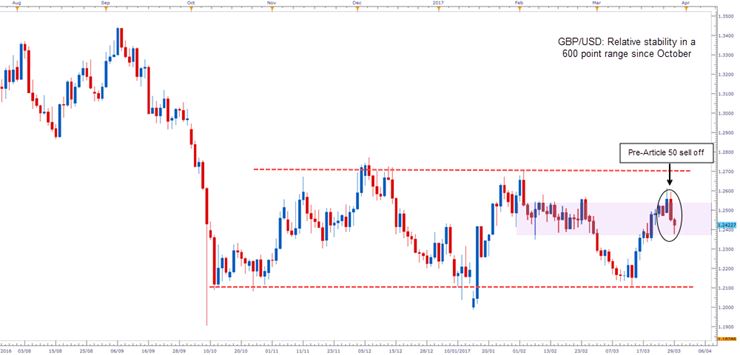The day has finally arrived – for those who voted for Brexit it is a day to celebrate as a bonfire is put under all those ‘banana’ shaped European regulations. Brexit will benefit everyone by expanding wealth and liberty so the 52% say. In contrast, those who voted to remain are labelling today Black Wednesday and other similar monikers. We are sheep being herded off a cliff and it is all self-inflicted, they cry.
In reality, the triggering of Article 50 is the exit clause that has started the clock for the two year deadline for the UK to leave the EU. This part of the Lisbon Treaty was only created in late 2009 and has never been used officially. (Greenland chose to leave the EU predecessor without also seceding from a member state). So starts the unpicking of 44 years of agreements and treaties which will ultimately need unanimous approval from more than 30 national and regional European parliaments.
From our perspective, looking at the fate of sterling, it is fascinating how little consensus there is about what will happen after today. On the one side, cable has overestimated the downside of Brexit and especially around $1.20, the pound is undervalued, some say by as much as 20% against most other major currencies. Therefore, any more benign trade deal will see cable rebound to $1.28 and higher. The flip side of the coin is far more worried about the implications of a ‘hard’ Brexit which they see as increasingly difficult to avoid. Time constraints and negotiation complexities will weigh on cable and push it towards $1.15.
Looking at the daily candle chart, we can see sterling moved lower yesterday having printed a new cycle high at 1.2615 two days ago. This came of course on the back of the Trump wobble. Prices had previously dipped in March to 1.2187 on the back of the Scottish referendum and disappointing domestic data. Prices are now in the February zone around 1.24-1.25 which of course is in the wider 600 point zone marked out since October last year.

What seems highly relevant in determining future direction is that the reaction of GBP will really highlight any potential outcomes of each point in the forthcoming negotiations. We have long known that sterling is currently a political currency and this will exacerbate with the ebbs and flows of negotiating. In fact, David Davis has stated that he is preparing for what ‘may be the most complicated negotiations of all time’. In which light, we note that the implied volatility of GBP/USD is hovering just below its long term average so as the UK moves closer to exit, we should see this change and higher sterling volatility.
In the more immediate near term, the UK Government won’t see any of the official key European red lines until EU leaders meeting at the end of April. We will therefore watch for initial posturing as the UK offers up some compromises, be it security and part payment of the ‘exit bill’ whilst the Europeans draw up many rouge lines to assume a tough bargaining position. For the market, the journey will be key rather than what eventually happens so playing the broad zone of 1.21-1.27 may well be the order of the next few months. We will also take into account the extreme bearish sterling positioning, less dovish central banks, the ‘Trump’ trade and European elections!
